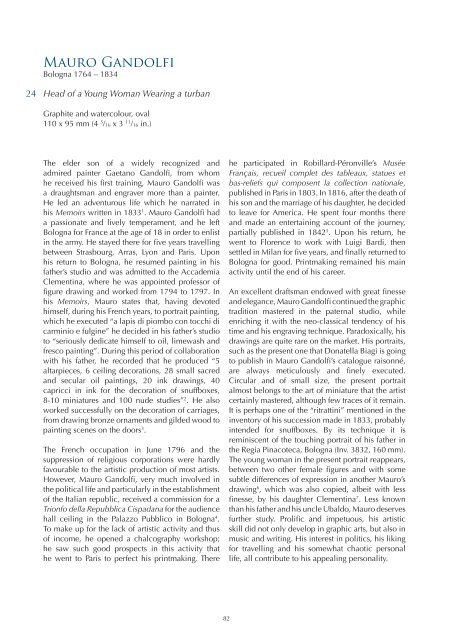XV - Works On Paper - Marty de Cambiaire (English)
Create successful ePaper yourself
Turn your PDF publications into a flip-book with our unique Google optimized e-Paper software.
Mauro Gandolfi<br />
Bologna 1764 – 1834<br />
24<br />
Head of a Young Woman Wearing a turban<br />
Graphite and watercolour, oval<br />
110 x 95 mm (4 5 /16 x 3 11 /16 in.)<br />
The el<strong>de</strong>r son of a wi<strong>de</strong>ly recognized and<br />
admired painter Gaetano Gandolfi, from whom<br />
he received his first training, Mauro Gandolfi was<br />
a draughtsman and engraver more than a painter.<br />
He led an adventurous life which he narrated in<br />
his Memoirs written in 1833 1 . Mauro Gandolfi had<br />
a passionate and lively temperament, and he left<br />
Bologna for France at the age of 18 in or<strong>de</strong>r to enlist<br />
in the army. He stayed there for five years travelling<br />
between Strasbourg, Arras, Lyon and Paris. Upon<br />
his return to Bologna, he resumed painting in his<br />
father’s studio and was admitted to the Acca<strong>de</strong>mia<br />
Clementina, where he was appointed professor of<br />
figure drawing and worked from 1794 to 1797. In<br />
his Memoirs, Mauro states that, having <strong>de</strong>voted<br />
himself, during his French years, to portrait painting,<br />
which he executed “a lapis di piombo con tocchi di<br />
carminio e fulgine” he <strong>de</strong>ci<strong>de</strong>d in his father’s studio<br />
to “seriously <strong>de</strong>dicate himself to oil, limewash and<br />
fresco painting”. During this period of collaboration<br />
with his father, he recor<strong>de</strong>d that he produced “5<br />
altarpieces, 6 ceiling <strong>de</strong>corations, 28 small sacred<br />
and secular oil paintings, 20 ink drawings, 40<br />
capricci in ink for the <strong>de</strong>coration of snuffboxes,<br />
8-10 miniatures and 100 nu<strong>de</strong> studies” 2 . He also<br />
worked successfully on the <strong>de</strong>coration of carriages,<br />
from drawing bronze ornaments and gil<strong>de</strong>d wood to<br />
painting scenes on the doors 3 .<br />
The French occupation in June 1796 and the<br />
suppression of religious corporations were hardly<br />
favourable to the artistic production of most artists.<br />
However, Mauro Gandolfi, very much involved in<br />
the political life and particularly in the establishment<br />
of the Italian republic, received a commission for a<br />
Trionfo <strong>de</strong>lla Repubblica Cispadana for the audience<br />
hall ceiling in the Palazzo Pubblico in Bologna 4 .<br />
To make up for the lack of artistic activity and thus<br />
of income, he opened a chalcography workshop;<br />
he saw such good prospects in this activity that<br />
he went to Paris to perfect his printmaking. There<br />
he participated in Robillard-Péronville’s Musée<br />
Français, recueil complet <strong>de</strong>s tableaux, statues et<br />
bas-reliefs qui composent la collection nationale,<br />
published in Paris in 1803. In 1816, after the <strong>de</strong>ath of<br />
his son and the marriage of his daughter, he <strong>de</strong>ci<strong>de</strong>d<br />
to leave for America. He spent four months there<br />
and ma<strong>de</strong> an entertaining account of the journey,<br />
partially published in 1842 5 . Upon his return, he<br />
went to Florence to work with Luigi Bardi, then<br />
settled in Milan for five years, and finally returned to<br />
Bologna for good. Printmaking remained his main<br />
activity until the end of his career.<br />
An excellent draftsman endowed with great finesse<br />
and elegance, Mauro Gandolfi continued the graphic<br />
tradition mastered in the paternal studio, while<br />
enriching it with the neo-classical ten<strong>de</strong>ncy of his<br />
time and his engraving technique. Paradoxically, his<br />
drawings are quite rare on the market. His portraits,<br />
such as the present one that Donatella Biagi is going<br />
to publish in Mauro Gandolfi’s catalogue raisonné,<br />
are always meticulously and finely executed.<br />
Circular and of small size, the present portrait<br />
almost belongs to the art of miniature that the artist<br />
certainly mastered, although few traces of it remain.<br />
It is perhaps one of the “ritrattini” mentioned in the<br />
inventory of his succession ma<strong>de</strong> in 1833, probably<br />
inten<strong>de</strong>d for snuffboxes. By its technique it is<br />
reminiscent of the touching portrait of his father in<br />
the Regia Pinacoteca, Bologna (Inv. 3832, 160 mm).<br />
The young woman in the present portrait reappears,<br />
between two other female figures and with some<br />
subtle differences of expression in another Mauro’s<br />
drawing 6 , which was also copied, albeit with less<br />
finesse, by his daughter Clementina 7 . Less known<br />
than his father and his uncle Ubaldo, Mauro <strong>de</strong>serves<br />
further study. Prolific and impetuous, his artistic<br />
skill did not only <strong>de</strong>velop in graphic arts, but also in<br />
music and writing. His interest in politics, his liking<br />
for travelling and his somewhat chaotic personal<br />
life, all contribute to his appealing personality.<br />
82
















